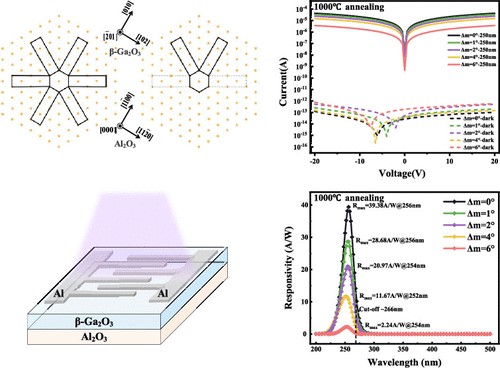
【Epitaxy Papers】Thermal Annealing Restricts the Rotation Domains of Epitaxial β-Ga₂O₃ Thin Films on Off-Angle Sapphire Substrates, Enabling Ultrahigh-Sensitivity Solar-Blind Deep UV Photodetector
日期:2025-03-21阅读:432
Researchers from the Northeast Normal University have published a dissertation titled "Thermal Annealing Restricts the Rotation Domains of Epitaxial β-Ga2O3 Thin Films on Off-Angle Sapphire Substrates, Enabling Ultrahigh-Sensitivity Solar-Blind Deep UV Photodetector" in ACS Applied Materials & Interfaces.

Abstract
β-Gallium oxide (Ga2O3) films with a (−201) preferential orientation were heteroepitaxially grown on aluminum oxide (c/m) substrates at off-angles of 0, 1, 2, 4, and 6° by using metal–organic chemical vapor deposition. The step-flow growth mode inhibited the formation of rotational domains, which were further suppressed by annealing at 1000 °C, resulting in two primary orientations. The crystalline quality, surface morphology, and oxygen vacancy concentration of the β-Ga2O3 films strongly depended on the off-angle of the substrate. Using the 6° tilted substrate and postannealing decreased the full width at half-maximum of the rocking curve of the β-Ga2O3 films to 0.88°, with a root-mean-square roughness of 5.88 nm and a marked reduction in oxygen vacancies. Under a 10 V bias and 254 nm (23.75 μW/cm2) illumination, the β-Ga2O3-based photoconductive-type solar-blind photodetector grown on the 0° substrate exhibited superior responsivity (39.38 A/W), detectivity (4.60 × 1016 Jones), and external quantum efficiency (19074%). The device fabricated on the 6° substrate exhibited faster response times (0.47/4.34 ms) because of the improved film quality, which reduced defect centers and increased the signal feedback speed. This study investigated the growth mechanism of heteroepitaxial β-Ga2O3 films on sapphire substrates with various off-angles and their influence on device performance. This concept may offer insights into the epitaxial growth and device design of other thin films.
DOI:
https://doi.org/10.1021/acsami.4c22220


